New Waste Management Options Created by iMAGINE through Direct Operation on Spent Nuclear Fuel Feed
Abstract
:1. Introduction
2. Code, Model, and Methods
3. Results
3.1. Setup
- -
- Clean, depleted uranium tailings (tailings);
- -
- Used/spent nuclear fuel without reprocessing (SNF);
- -
- An increased amount of fission products that would be in the reactor system when the already separated fission products would be added to perform a kind of P&T operation on already vitrified leftovers of previous reprocessing approaches (SNF + FP).
3.2. The Reference Case Study
3.3. Parametric Study of Different Fission Product Contents
4. Conclusions
Author Contributions
Funding
Data Availability Statement
Acknowledgments
Conflicts of Interest
References
- Arkhipov, V. Future Nuclear Energy Systems: Generating Electricity, Burning Wastes. Iaea Bulletin, 39/2/1997. 1997. Available online: https://www.iaea.org/sites/default/files/publications/magazines/bulletin/bull39-2/39204783033.pdf (accessed on 27 February 2015).
- Merk, B.; Litskevich, D.; Detkina, A.; Noori-kalkhoran, O.; Jain, L.; Derrer-Merk, E.; Aflyatunova, D.; Cartland-Glover, G. iMAGINE—Visions, Missions, and Steps for Successfully Delivering the Nuclear System of the 21st Century. Energies 2023, 16, 3120. [Google Scholar] [CrossRef]
- Merk, B.; Litskevich, D.; Whittle, K.R.; Bankhead, M.; Taylor, R.J.; Mathers, D. On a Long Term Strategy for the Success of Nuclear Power. Energies 2017, 10, 867. [Google Scholar] [CrossRef]
- Merk, B.; Litskevich, D.; Peakman, A.; Bankhead, M. IMAGINE—A Disruptive Change to Nuclear or How Can We Make More Out of the Existing Spent Nuclear Fuel and What Has to be Done to Make it Possible in the UK? Atw Int. J. Nucl. Power 2019, 64, 353–359. [Google Scholar]
- Merk, B.; Detkina, A.; Litskevich, D.; Patel, M.; Noori-kalkhoran, O.; Cartland-Glover, G.; Efremova, O.; Bankhead, M.; Degueldre, C. A First Step towards Zero Nuclear Waste—Advanced Strategic Thinking in Light of iMAGINE. Energies 2022, 15, 7209. [Google Scholar] [CrossRef]
- Knebel, J.U.; Fazio, C.; Ait Abderrahim, H.; D’hondt, P.; Benamati, G.; Monti, S.; Gonzalez, E.; Pillon, S.; Warin, D. IP EUROTRANS: A European Research Programme for the Transmutation of High Level Nuclear Waste in an Accelerator Driven System. In Proceedings of the Actinide and Fission Product Partitioning & Transmutation Eighth Information Exchange Meeting, Las Vegas, NV, USA, 9–11 November 2004; Available online: http://www.oecd-nea.org/pt/docs/iem/lasvegas04/11_Session_V/S5_01.pdf (accessed on 10 June 2013).
- Madic, C.; Boullis, B.; Baron, P.; Testard, F.; Hudson, M.; Liljenzin, J.-O.; Christiansen, B.; Ferrando, M.; Facchini, A.; Geist, A.; et al. Futuristic back-end of the nuclear fuel cycle with the partitioning of minor actinides. J. Alloys Compd. 2007, 444–445, 23–27. [Google Scholar] [CrossRef]
- Merk, B.; Litskevich, D.; Peakman, A.; Bankhead, M. The Current Status of Partitioning & Transmutation and How to Develop a Vision for Nuclear Waste Management. Atw Int. J. Nucl. Power 2019, 64, 261–266. [Google Scholar]
- Khaperskaya, A.; Khomyakov, Y.; Shadrin, A.; Feinberg, O. Conceptual approaches and the main directions of R & D on partitioning and transmutation of minor actinides and long-lived fission products in the Russian Federation State atomic energy corporation “Rosatom”, Manchester. In Proceedings of the 15th International Exchange Meeting on Partitioning and Transmutation, Manchester, UK, 2 October 2018. [Google Scholar]
- Merk, B.; Litskevich, D.; Bankhead, M.; Taylor, R.J. An innovative way of thinking nuclear waste management—Neutron physics of a reactor directly operating on SNF. PLoS ONE 2017, 12, e0180703. [Google Scholar] [CrossRef]
- Acatech (Ed.) Partitioning and Transmutation of Nuclear Waste; Opportunities and Risks in Research and Application (acatech POSITION PAPER); Acatech: Munich, Germany, 2014. [Google Scholar]
- Renn, O. Partitionierung und Transmutation Forschung—Entwicklung—Gesellschaftliche Implikationen (Acatech STUDIE Dezember 2013); acatech–Deutsche Akademie der Technikwissenschaften: Munich, Germany, 2014. [Google Scholar]
- Merk, B.; Detkina, A.; Litskevich, D.; Noori-Kalkhoran, O.; Cartland-Glover, G. A HELIOS-Based Dynamic Salt Clean-Up Study for iMAGINE. Appl. Sci. 2022, 12, 8748. [Google Scholar] [CrossRef]
- Merk, B.; Litskevich, D. Transmutation of All German Transuranium under Nuclear Phase Out Conditions—Is This Feasible from Neutronic Point of View? PLoS ONE 2015, 10, e0145652. [Google Scholar] [CrossRef]
- Merk, B.; Rohde, U.; Glivici-Cotruta, V.; Litskevich, D.; Scholl, S. On the Use of a Molten Salt Fast Reactor to Apply an Idealized Transmutation Scenario for the Nuclear Phase Out. PLoS ONE 2014, 9, e92776. [Google Scholar] [CrossRef]
- HELIOS2 Methods Manual; Version 2.03.01; SSP-11/452 Rev 6; Studsvik Scandpower, Inc.: Idaho Falls, ID, USA, 12 January 2021.
- Villarino, E.A.; Stammler, R.J.J.; Ferri, A.; Casal, J.J. HELIOS: Angularly dependent collision probabilities. Nucl. Sci. Eng. 1992, 112, 16–31. [Google Scholar] [CrossRef]
- Wemple, C.A.; Gheorghiu, H.-N.M.; Stamm’ler, R.J.J.; Villarino, E.A. Recent Advances in the HELIOS-2 Lattice Physics Code. In Proceedings of the International Conference on the Physics of Reactors “Nuclear Power: A Sustainable Resource”, Interlaken, Switzerland, 14–19 September 2008. [Google Scholar]
- Evaluation and Viability of Liquid Fuel Fast Reactor System EVOL, DELIVERABLE D2.1, Design Parameters Definition for Most Stable Salt Flux, Rev 3 30/04/2012. Available online: https://cordis.europa.eu/project/id/249696 (accessed on 8 March 2022).
- Brovchenko, M.; Kloosterman, J.-L.; Luzzi, L.; Merle, E.; Heuer, D.; Laureau, A.; Feynberg, O.; Ignatiev, V.; Aufiero, M.; Cammi, A.; et al. Neutronic benchmark of the molten salt fast reactor in the frame of the EVOL and MARS collaborative projects. EPJ Nuclear Sci. Technol. 2019, 5, 2. [Google Scholar] [CrossRef]
- Merk, B.; Detkina, A.; Atkinson, S.; Litskevich, D.; Cartland-Glover, G. Catland-Glover: Evaluation of the Breeding Performance of a NaCl-UCl-Based Reactor System. Energies 2019, 12, 3853. [Google Scholar] [CrossRef]
- Kozlowski, T.; Downar, T.J. OECD/NEA and U.S. NRC PWR MOX/UO2 Core Transient Benchmark; Final Specifications, Revision 2; Purdue University: West Lafayette, IN, USA, 2003; Available online: https://www.oecd-nea.org/upload/docs/application/pdf/2020-10/mox_benchmark_specifications_2003.pdf (accessed on 5 June 2023).
- Aurora User Manual; SSP-11/451 Rev 8; Studsvik Scandpower, Inc.: Idaho Falls, ID, USA, 12 January 2021.
- Zenith User Manual; SSP-11/460 Rev. 5; Studsvik Scandpower, Inc.: Idaho Falls, ID, USA, 8 December 2020.
- Merk, B.; Litskevich, D. On the Burning of Plutonium Originating from Light Water Reactor Use in a Fast Molten Salt Reactor-A Neutron Physical Study. Energies 2015, 8, 12557–12572. [Google Scholar] [CrossRef]
- Merk, B.; Litskevich, D. A disruptive approach to eliminating weapon-grade plutonium—Pu burning in a molten salt fast reactor. PLoS ONE 2018, 13, e0201757. [Google Scholar] [CrossRef] [PubMed]
- Rachamin, R.; Wemple, C.; Fridman, E. Neutronic analysis of SFR core with HELIOS-2, Serpent, and DYN3D codes. Ann. Nucl. Energy 2013, 55, 194–204. [Google Scholar] [CrossRef]
- Detkina, A.; Litskevich, D.; Drury, M.; Merk, B. Zero Power Experiment for Molten Salt Reactor—Code Verification and Validation Request. In Proceedings of the International Conference on Physics of Reactors, Pittsburgh, PA, USA, 15–20 May 2022. [Google Scholar]
- Merk, B.; Litskevich, D.; Gregg, R.; Mount, A.R. Demand driven salt clean-up in a molten salt fast reactor—Defining a priority list. PLoS ONE 2018, 13, e0192020. [Google Scholar] [CrossRef] [PubMed]
- Merk, B.; Detkina, A.; Litskevich, D.; Drury, M.; Noori-kalkhoran, O.; Cartland-Glover, G.; Petit, L.; Rolfo, S.; Elliott, J.P.; Mount, A.R. Defining the Challenges—Identifying the Key Poisoning Elements to Be Separated in a Future Integrated Molten Salt Fast Reactor Clean-Up System for iMAGINE. Appl. Sci. 2022, 12, 4124. [Google Scholar] [CrossRef]
- Degueldre, C.; Merk, B. Use of chloride-37 in Molten Salt Fast Reactor for ecological and economical reasons. Prog. Nuclear Energy, 2023; Submitted. [Google Scholar]
- Jaag, S.; Kiefhaber, E. Americium Incineration—Challenge in Plutonium Burning and Minor Actinide Transmutation; American Nuclear Society: La Grange Park, IL, USA, 1999. [Google Scholar]
- Merk, B. Moderating Material to Compensate the Drawback of High Minor Actinide Containing Transmutation Fuel on the Feedback Effects in SFR Cores. Sci. Technol. Nucl. Install. 2013, 2013, 172518. [Google Scholar] [CrossRef]
- Gulevich, A.V.; Eliseev, V.A.; Klinov, D.A.; Korobeinikova, L.V.; Kryachko, M.V.; Pershukov, V.A.; Troyanov, V.M. Possibility of Burning Americium in Fast Reactors. At. Energy 2020, 128, 88–94. [Google Scholar] [CrossRef]
- Merk, B.; Devan, K.; Bachchan, A.; Paul, D.; Puthiyavinayagam, P.; Srinivasan, G. Can enhanced feedback effects and improved breeding coincide in a metal fueled, sodium cooled fast reactor? Ann. Nucl. Energy 2017, 105, 205–218. [Google Scholar] [CrossRef]


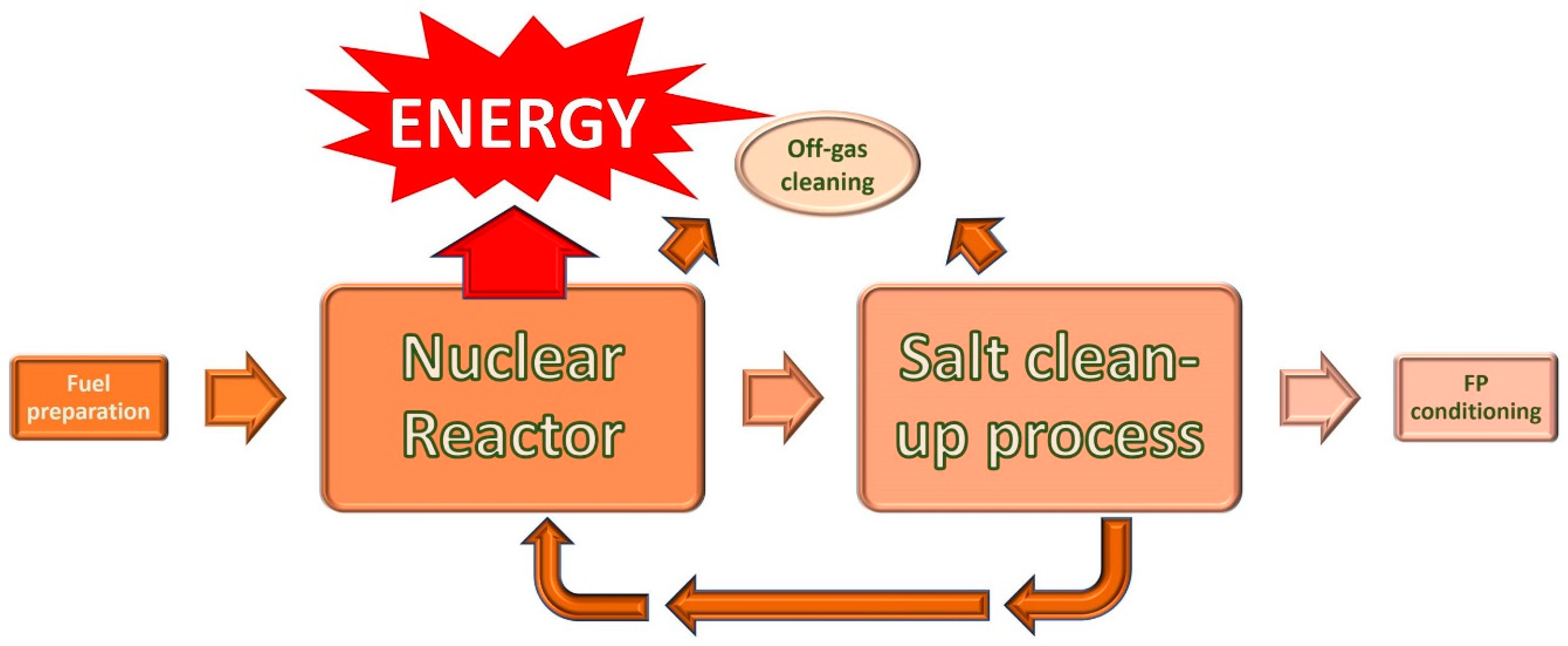


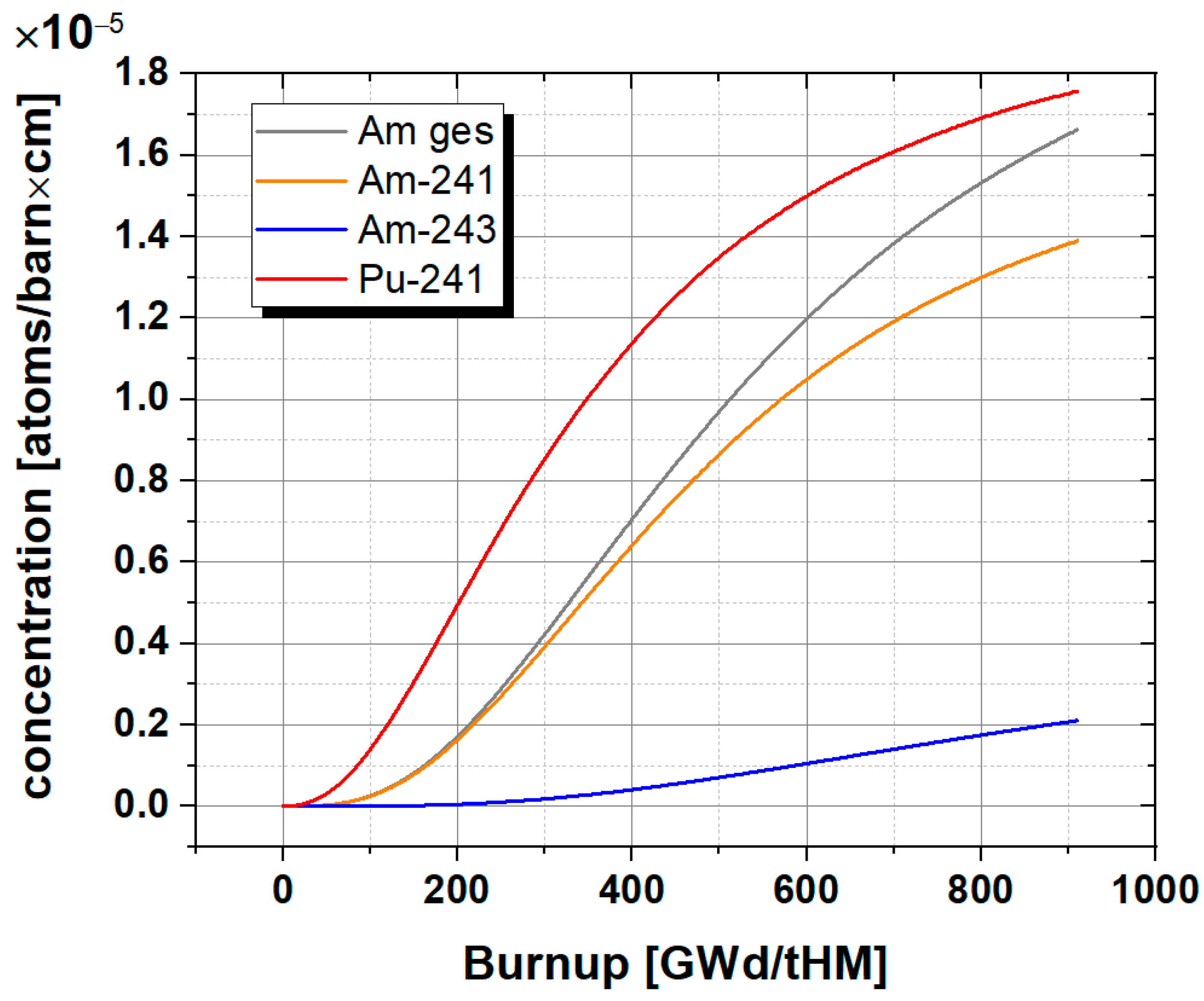
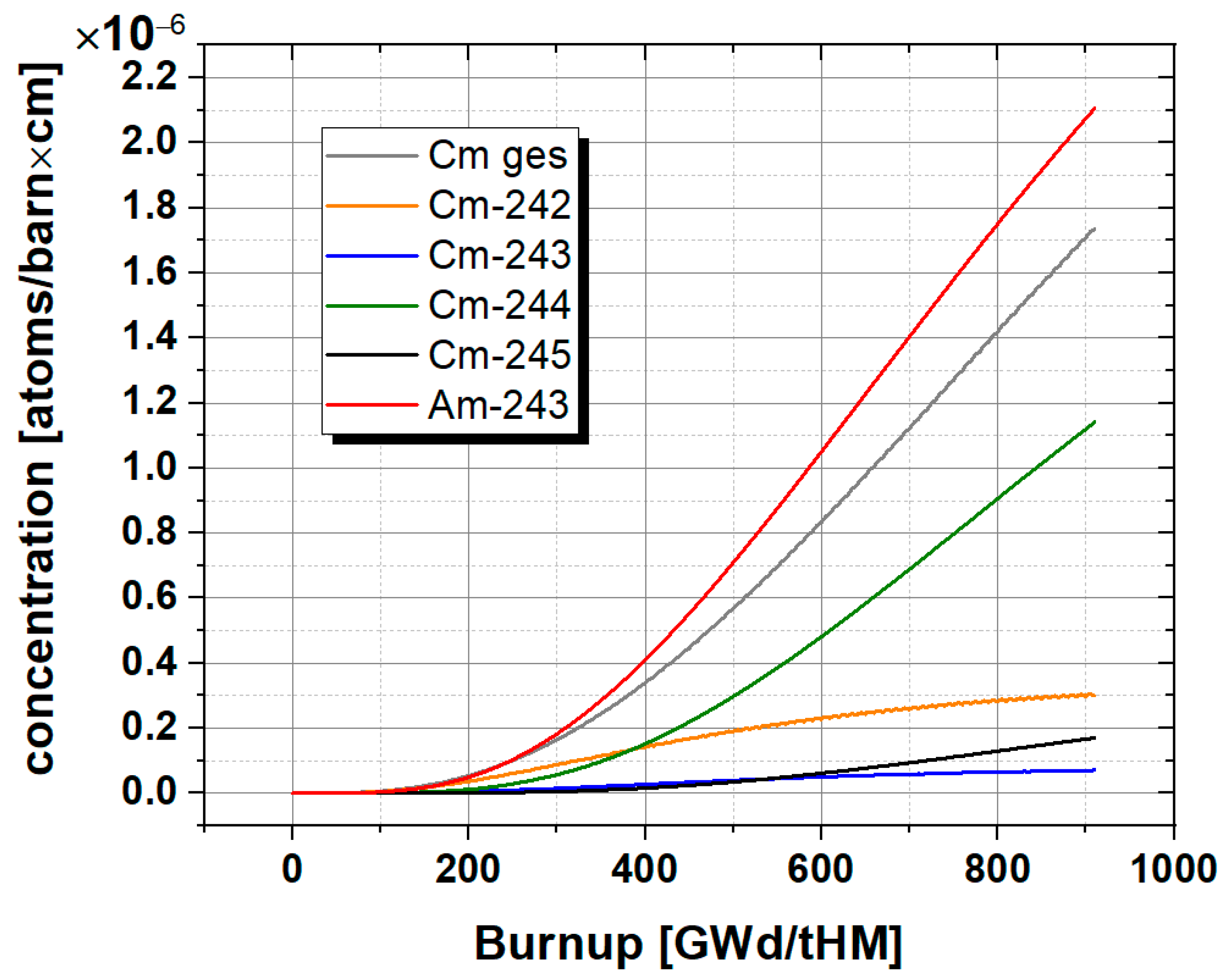
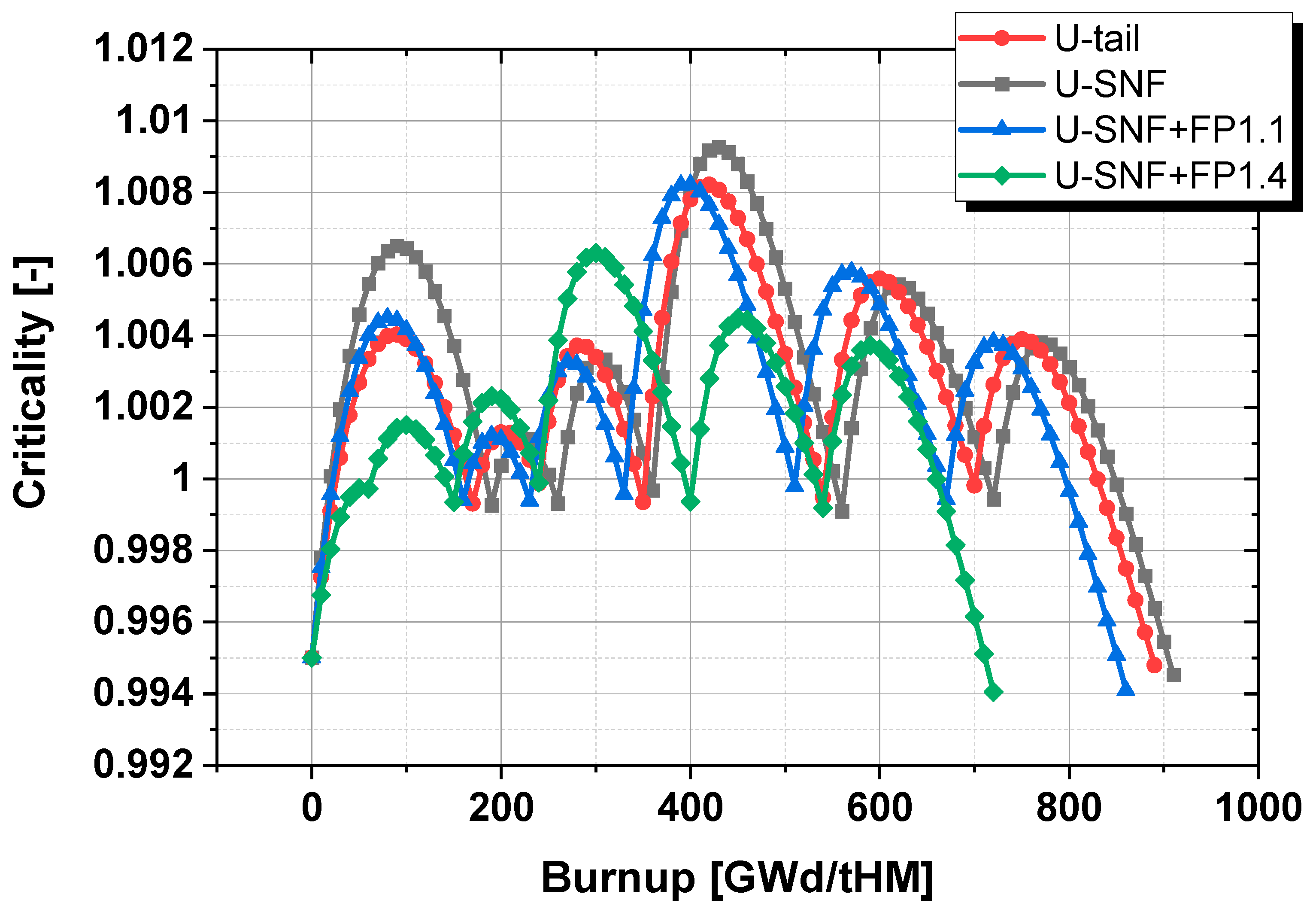


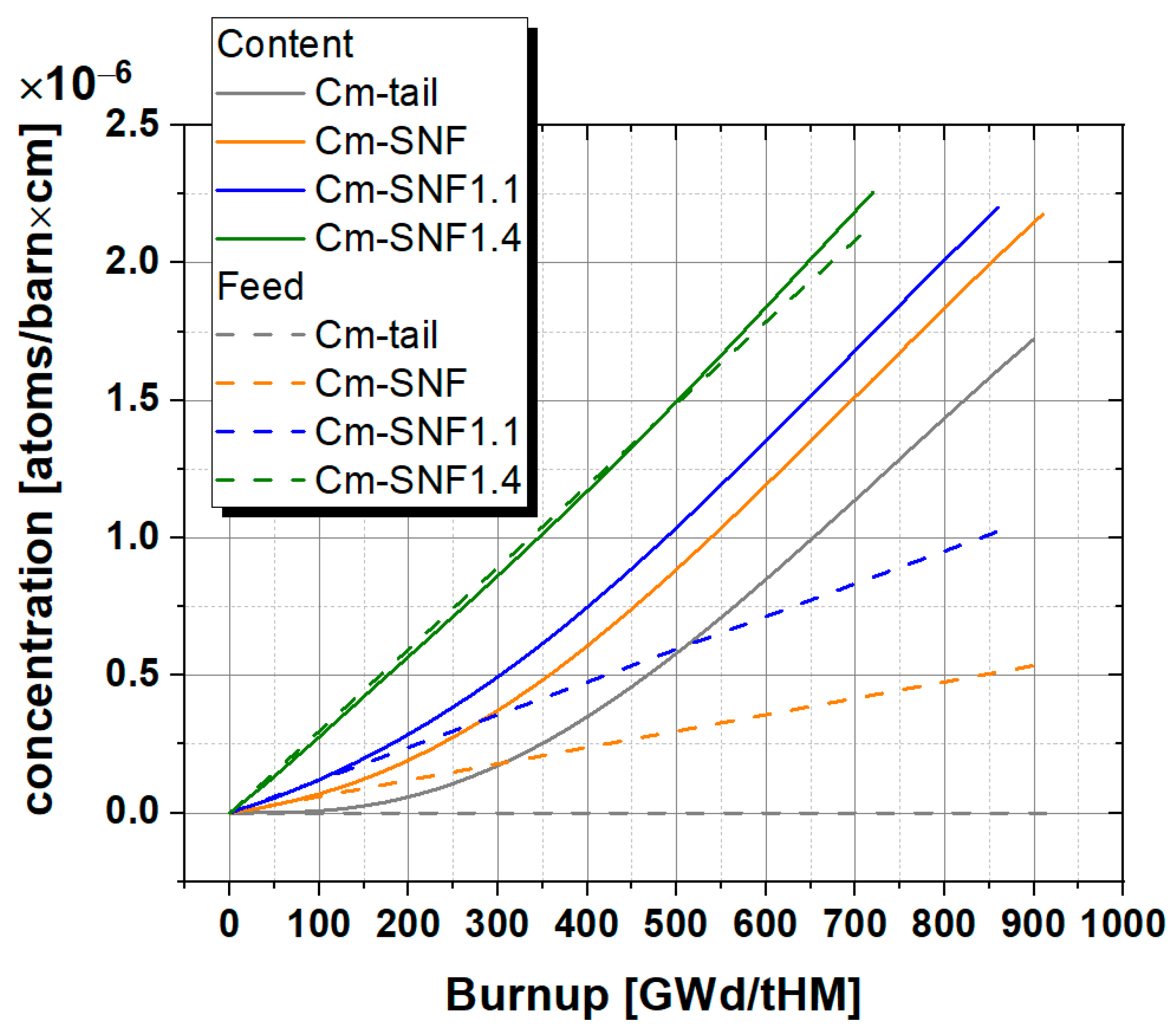
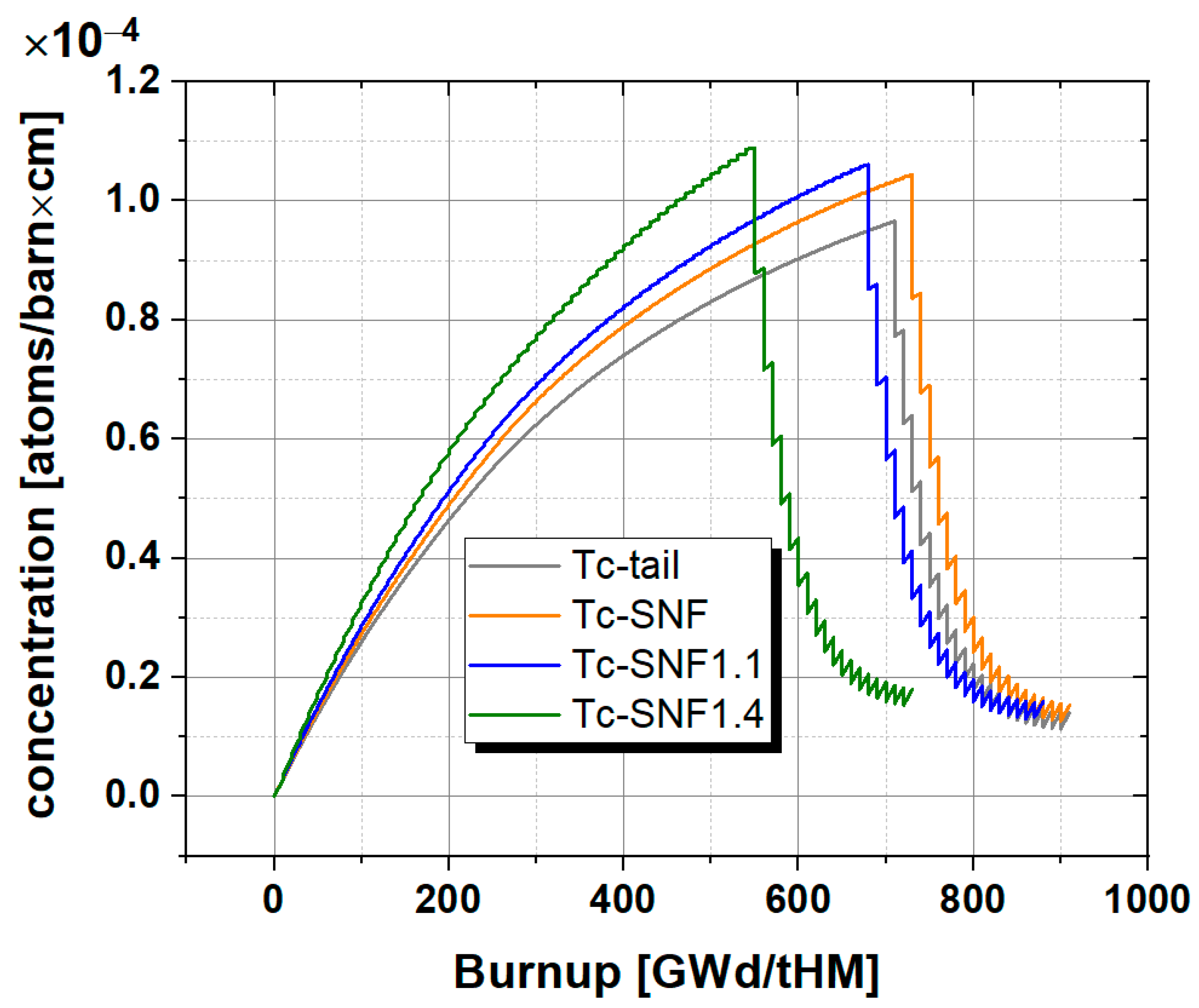
| Pu-Tail [atoms/barn × cm] | Pu-SNF [atoms/barn × cm] | Pu-SNF1.1 [atoms/barn × cm] | Pu-SNF1.4 [atoms/barn × cm] | |
|---|---|---|---|---|
| Amount fed | 0 | 5.56 × 10−5 | 5.26 × 10−5 | 4.40 × 10−5 |
| Amount resident | 6.79 × 10−4 | 6.94 × 10−4 | 6.90 × 10−4 | 6.81 × 10−4 |
| Pu reduction | −6% | −6% | −6% |
| Am-Tail [atoms/barn × cm] | Am-SNF [atoms/barn × cm] | Am-SNF1.1 [atoms/barn × cm] | Am-SNF1.4 [atoms/barn × cm] | |
|---|---|---|---|---|
| Amount fed | 0 | 1.12 × 10−6 | 2.13 × 10−6 | 4.45 × 10−6 |
| Amount resident | 1.66 × 10−5 | 1.80 × 10−5 | 1.77 × 10−5 | 1.63 × 10−5 |
| Am change | 2% | −6% | −28% |
| Cm-Tail [atoms/barn × cm] | Cm-SNF [atoms/barn × cm] | Cm-SNF1.1 [atoms/barn × cm] | Cm-SNF1.4 [atoms/barn × cm] | |
|---|---|---|---|---|
| Amount fed | 0 | 5.42 × 10−7 | 1.02 × 10−6 | 2.14 × 10−6 |
| Amount resident | 1.72 × 10−6 | 2.18 × 10−6 | 2.20 × 10−6 | 2.26 × 10−6 |
| Cm reduction | −5% | −32% | −93% |
| Feedback [pcm/K] | |
|---|---|
| BOL | −6.0 |
| EOL-tail | −5.8 |
| EOL-SNF | −3.7 |
| EOL-SNF 1.1 | −3.8 |
| EOL-SNF 1.4 | −3.8 |
Disclaimer/Publisher’s Note: The statements, opinions and data contained in all publications are solely those of the individual author(s) and contributor(s) and not of MDPI and/or the editor(s). MDPI and/or the editor(s) disclaim responsibility for any injury to people or property resulting from any ideas, methods, instructions or products referred to in the content. |
© 2023 by the authors. Licensee MDPI, Basel, Switzerland. This article is an open access article distributed under the terms and conditions of the Creative Commons Attribution (CC BY) license (https://creativecommons.org/licenses/by/4.0/).
Share and Cite
Merk, B.; Detkina, A.; Noori-kalkhoran, O.; Jain, L.; Litskevich, D.; Cartland-Glover, G. New Waste Management Options Created by iMAGINE through Direct Operation on Spent Nuclear Fuel Feed. Energies 2023, 16, 7420. https://doi.org/10.3390/en16217420
Merk B, Detkina A, Noori-kalkhoran O, Jain L, Litskevich D, Cartland-Glover G. New Waste Management Options Created by iMAGINE through Direct Operation on Spent Nuclear Fuel Feed. Energies. 2023; 16(21):7420. https://doi.org/10.3390/en16217420
Chicago/Turabian StyleMerk, Bruno, Anna Detkina, Omid Noori-kalkhoran, Lakshay Jain, Dzianis Litskevich, and Gregory Cartland-Glover. 2023. "New Waste Management Options Created by iMAGINE through Direct Operation on Spent Nuclear Fuel Feed" Energies 16, no. 21: 7420. https://doi.org/10.3390/en16217420
APA StyleMerk, B., Detkina, A., Noori-kalkhoran, O., Jain, L., Litskevich, D., & Cartland-Glover, G. (2023). New Waste Management Options Created by iMAGINE through Direct Operation on Spent Nuclear Fuel Feed. Energies, 16(21), 7420. https://doi.org/10.3390/en16217420








